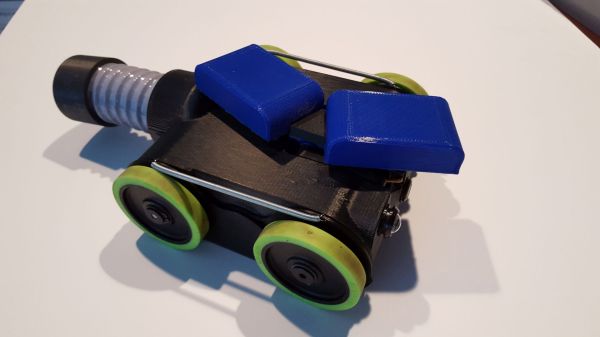Dry Casks 101: What Do Robots Have to do With Dry Cask Storage?
Posted by on August 4, 2016
Darrell Dunn
Materials Engineer
 Cutting-edge robot technology is making it easier to inspect inside spent fuel dry cask storage systems.
Cutting-edge robot technology is making it easier to inspect inside spent fuel dry cask storage systems.
You may remember from past blog posts that most spent fuel dry cask storage systems, or casks, consist of stainless steel canisters that are welded shut to safely contain the radioactive contents. The canisters are in turn placed inside thick storage overpacks to shield plant workers and the public from radiation. As these casks remain in use for longer time frames, the ability to inspect canister surfaces and welds will become an important aspect of the NRC’s confidence in their safety.
To be clear: techniques for inspecting canister surfaces and welds have been used for decades. These techniques are collectively known as nondestructive examination (NDE) and include a variety of methods, such as visual, ultrasonic, eddy current and guided wave examinations.
 Where
do robots come in? They are a delivery system. Robots are being
developed to apply these NDE techniques inside casks. Not just any robot
will do. These robots need to fit into small spaces and withstand the
heat and radiation inside the cask. The state-of-the-art is evolving
quickly.
Where
do robots come in? They are a delivery system. Robots are being
developed to apply these NDE techniques inside casks. Not just any robot
will do. These robots need to fit into small spaces and withstand the
heat and radiation inside the cask. The state-of-the-art is evolving
quickly.
To date, the Electric Power Research Institute and cask manufacturers have successfully demonstrated robotic inspection techniques to NRC staff three times: at the Palo Verde plant in Arizona (Sept. 2-3, 2015), at the McGuire plant in North Carolina (May 16-19, 2016), and just last month, at Maine Yankee (July 12-13, 2016).
At Palo Verde, the robot was used to deliver eddy current testing instrumentation inside a cask. Eddy current testing detects variations in electromagnetically induced currents in metals. Because it is sensitive to surface defects, eddy current testing is a preferred method for detecting cracks. The inspection robot was used to examine part of the mockup canister fabrication weld. An EPRI report provides a detailed description of the Palo Verde test. Future reports are expected on the McGuire and Maine Yankee demonstrations. These demonstrations are helping to refine the robots’ designs.
 The
Maine Yankee demo was conducted in July 2016 on a cask loaded in 2002.
The demo involved a robot maneuvering a camera with a fiber optic probe,
which meets the industry code for visual examinations, inside the cask.
The probe was able to access the entire height of the canister,
allowing the camera to capture images of the fabrication and closure
welds. The welds showed no signs of degradation. The canister was intact
and in good condition.
The
Maine Yankee demo was conducted in July 2016 on a cask loaded in 2002.
The demo involved a robot maneuvering a camera with a fiber optic probe,
which meets the industry code for visual examinations, inside the cask.
The probe was able to access the entire height of the canister,
allowing the camera to capture images of the fabrication and closure
welds. The welds showed no signs of degradation. The canister was intact
and in good condition.
The robot was also able to obtain samples from surfaces of the cask and canister. These samples are being analyzed for atmospheric deposits that could cause corrosion.
Ultimately, if degradation is identified, cask users would select their preferred mitigation and repair option. They would have to meet the NRC’s safety requirements before implementing it.
Cask inspections are important to ensure continued safe storage of spent nuclear fuel and robots will continue to be a helpful tool in this important activity.
Materials Engineer
 Cutting-edge robot technology is making it easier to inspect inside spent fuel dry cask storage systems.
Cutting-edge robot technology is making it easier to inspect inside spent fuel dry cask storage systems.You may remember from past blog posts that most spent fuel dry cask storage systems, or casks, consist of stainless steel canisters that are welded shut to safely contain the radioactive contents. The canisters are in turn placed inside thick storage overpacks to shield plant workers and the public from radiation. As these casks remain in use for longer time frames, the ability to inspect canister surfaces and welds will become an important aspect of the NRC’s confidence in their safety.
To be clear: techniques for inspecting canister surfaces and welds have been used for decades. These techniques are collectively known as nondestructive examination (NDE) and include a variety of methods, such as visual, ultrasonic, eddy current and guided wave examinations.
 Where
do robots come in? They are a delivery system. Robots are being
developed to apply these NDE techniques inside casks. Not just any robot
will do. These robots need to fit into small spaces and withstand the
heat and radiation inside the cask. The state-of-the-art is evolving
quickly.
Where
do robots come in? They are a delivery system. Robots are being
developed to apply these NDE techniques inside casks. Not just any robot
will do. These robots need to fit into small spaces and withstand the
heat and radiation inside the cask. The state-of-the-art is evolving
quickly.To date, the Electric Power Research Institute and cask manufacturers have successfully demonstrated robotic inspection techniques to NRC staff three times: at the Palo Verde plant in Arizona (Sept. 2-3, 2015), at the McGuire plant in North Carolina (May 16-19, 2016), and just last month, at Maine Yankee (July 12-13, 2016).
At Palo Verde, the robot was used to deliver eddy current testing instrumentation inside a cask. Eddy current testing detects variations in electromagnetically induced currents in metals. Because it is sensitive to surface defects, eddy current testing is a preferred method for detecting cracks. The inspection robot was used to examine part of the mockup canister fabrication weld. An EPRI report provides a detailed description of the Palo Verde test. Future reports are expected on the McGuire and Maine Yankee demonstrations. These demonstrations are helping to refine the robots’ designs.
 The
Maine Yankee demo was conducted in July 2016 on a cask loaded in 2002.
The demo involved a robot maneuvering a camera with a fiber optic probe,
which meets the industry code for visual examinations, inside the cask.
The probe was able to access the entire height of the canister,
allowing the camera to capture images of the fabrication and closure
welds. The welds showed no signs of degradation. The canister was intact
and in good condition.
The
Maine Yankee demo was conducted in July 2016 on a cask loaded in 2002.
The demo involved a robot maneuvering a camera with a fiber optic probe,
which meets the industry code for visual examinations, inside the cask.
The probe was able to access the entire height of the canister,
allowing the camera to capture images of the fabrication and closure
welds. The welds showed no signs of degradation. The canister was intact
and in good condition.The robot was also able to obtain samples from surfaces of the cask and canister. These samples are being analyzed for atmospheric deposits that could cause corrosion.
Ultimately, if degradation is identified, cask users would select their preferred mitigation and repair option. They would have to meet the NRC’s safety requirements before implementing it.
Cask inspections are important to ensure continued safe storage of spent nuclear fuel and robots will continue to be a helpful tool in this important activity.

No comments:
Post a Comment